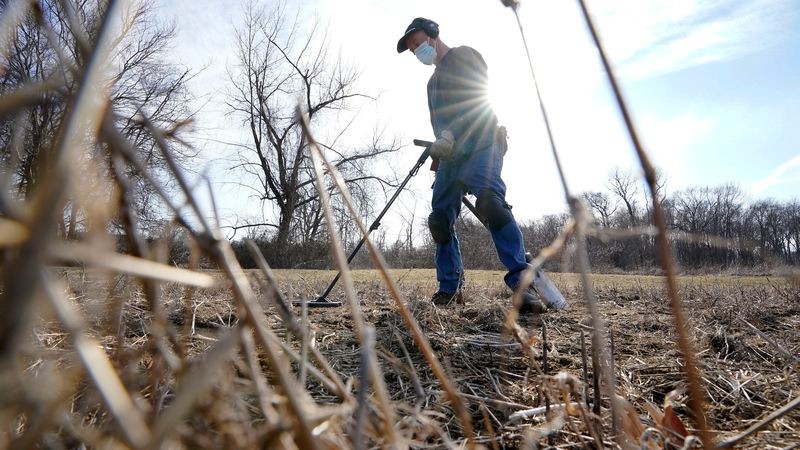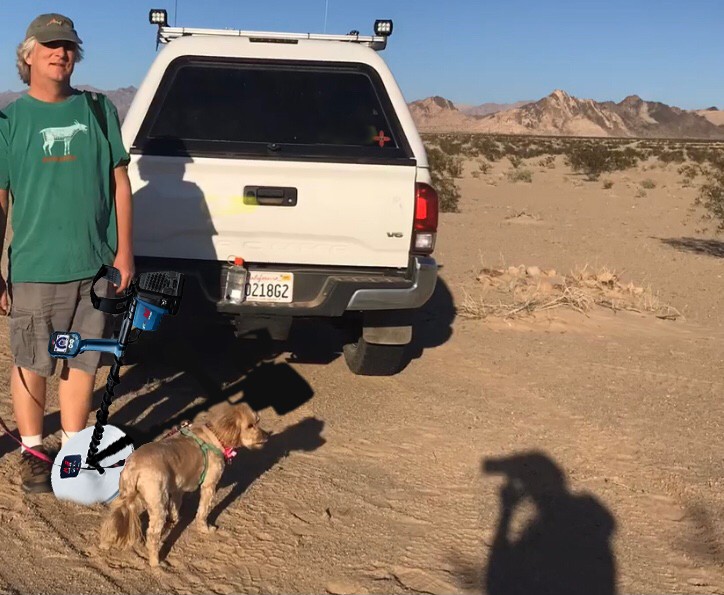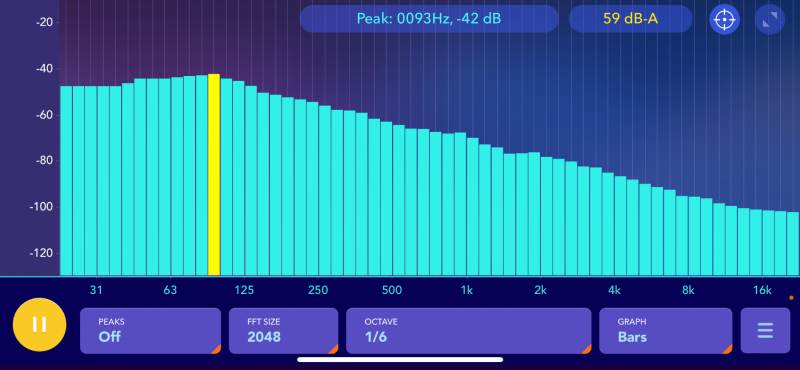-
Posts
1,097 -
Joined
-
Last visited
Content Type
Forums
Detector Prospector Home
Detector Database
Downloads
Everything posted by GotAU?
-

Moving Boulders To Find Placer Gold
GotAU? replied to Smithsgold's topic in Detector Prospector Forum
Nice! You’re gonna need a bigger boulder mover, time for a 4-ton GripHoist! -

Official Minelab GPX 6000 Page
GotAU? replied to Steve Herschbach's topic in Detector Prospector Forum
Those comparison tests you mentioned are exactly the types people would like to see, the only other ones I can think of is operational dependability, durability, and perhaps rate of return vs that of other detector models. But there’s a lot of variables that would go into that comparison including goldfield depletion, gold prices, and effort, so I’m not sure how that type of measurement could be done. -
Or perhaps also pulses a certain number or length for discrimination in addition to a speed to show signal strength?
-

Black Rock Covered In Sparkles
GotAU? replied to Carol Reynolds's topic in Rocks, Minerals, Gems & Geology
Hi Carol, welcome! That is a very nice specimen. Steve may move this post to the Mineral and Gem forum as it was accidentally misplaced in the wrong forum here, but I wanted to help out anyways. For future mineral id info- post rocks and minerals here:https://www.detectorprospector.com/forums/forum/51-rocks-minerals-gems-geology/ Anyways, my guess is a type of hematite (iron oxide crystal) known as specularite. There are better photos that better match it on the internet (google specularite or look here: https://www.bluegems.com.au/shop/minerals-jewellery-gems/a-hematite-and-quartz/), but minedat has good physical info about it. https://www.mindat.org/min-5574.html Glad you like rocks and minerals too! 😀 -

Official Minelab GPX 6000 Page
GotAU? replied to Steve Herschbach's topic in Detector Prospector Forum
I really enjoy their style, they undoubtedly would be great ambassadors for Minelab if they would use them. Minelab obviously has a professional marketing team or contracts with an outside firm that has no clue what their customers are like. -

Official Minelab GPX 6000 Page
GotAU? replied to Steve Herschbach's topic in Detector Prospector Forum
Prospecting Men of Minelab Calendar coming soon! 🙄 -
Very nice find (20” of sand 😉) Did you use that scoop to dig out the main hole, or just use it when you were getting down near the bottom? I’m trying to figure out what best to use as I am thinking of trying out beach detecting for the first time and am not sure what scoop to get for dry and wet sand yet. Is that a CJK tank scoop? And yeah, you are lucky I didn’t take modeling lessons for my GPX 6000 photoshop job on that other post!😁
-

Official Minelab GPX 6000 Page
GotAU? replied to Steve Herschbach's topic in Detector Prospector Forum
The GPX Files - a new mystery show? -

Official Minelab GPX 6000 Page
GotAU? replied to Steve Herschbach's topic in Detector Prospector Forum
Seriously, its all just Indiana Jones Thunder down under guys- even for their newest model billed as being very light. Why not show more types of people using it in their ads? Another marketing opportunity lost. -

Official Minelab GPX 6000 Page
GotAU? replied to Steve Herschbach's topic in Detector Prospector Forum
This is also why Minelab really needs more diverse models, it would help them develop a larger customer base. 🤔 -
Captain Henry Every was a 17th century pirate that took an Indian trading vessel and disappeared with it’s passengers, gold and silver aboard and was the subject of a worldwide manhunt but was never found. And then came along a detectorist who may have helped solve a part of the mystery: https://www.tampabay.com/news/nation-world/2021/04/01/ancient-coins-may-solve-mystery-of-murderous-1600s-pirate/?outputType=amp EDIT: Alternate link: https://apnews.com/article/ancient-coins-may-solve-mystery-1600s-pirate-f5a6151b74e0dcf96de585eab451f90c And here's a pic of the detectorist in the article if anyone cant see it:
-
This was our first test with her out in the Mojave Desert, and all I can say it is very easy to walk about detecting with this one. Firstly, there was no stooping over with a scoop to pick up bad targets with this detector, they were all the real thing! And GeoSense works amazingly well, love being able to go with her automatically and easily keeping up with wherever I detected, it was a breeze. I've detected with others that were unwieldly and hard to control in the desert, but I can say this one is really something special. We walked for a couple miles on the edge of a dry lake looking for meteorites and she really showed her stuff. She almost seemed to know her way over the salty ground, and picked up anything I threw at her. She easily found nuggets of every size left behind by many others, and was very quiet and hardly made any noise anywhere I went, even in the most briny parts of the ground covered with white salt, underneath the buzzing high tension power lines that cross parts of the dry lake, and even going over hot rocks did not seem to bother her much. She's quite a detector and we are finally really lucky to have one like this! All I can say is wow, everyone should have one like this for detecting! June is a great detector dog, we rescued her from the pound, and one day I hope to find a GPX 6000 too. Happy April 1st!
-

Official Minelab GPX 6000 Page
GotAU? replied to Steve Herschbach's topic in Detector Prospector Forum
A person could easily tell salty and boron laden hot ground just by learning the type of plants growing in an area. Saltbush or shadscale, and iodine bush are good indicators of this, as they are the most salt tolerant shrubs in the Great Basin desert. -

Official Minelab GPX 6000 Page
GotAU? replied to Steve Herschbach's topic in Detector Prospector Forum
Most of the desert here has open areas easily detected for a lack of those, but they certainly do create areas that foil a good hunt wherever they occur. I like everyone else must then tend to go where they arent for it, but if the 6000 is truly effective and quiet underneath powerlines as shown, it will open areas up and we can truly ignore them, hence “what are powerlines?” -

Official Minelab GPX 6000 Page
GotAU? replied to Steve Herschbach's topic in Detector Prospector Forum
What are powerlines? 😄 OK, It’s quiet and light, that’s a given. I really can't wait for the report, it will be good when we get those here from the real users, just don’t take it over my digs! 😉 -

Official Minelab GPX 6000 Page
GotAU? replied to Steve Herschbach's topic in Detector Prospector Forum
Still waiting for some real in the field comparisons, but I got that it’s really light. -

Cannonballs - Not Worth Dying For
GotAU? replied to Steve Herschbach's topic in Metal Detecting For Coins & Relics
All unexploded ordinance (UXO) disarming operations I’ve seen used a automatic or remotely controlled saw, drill, or a disruptor device to disarm shells, in addition to sandbagging. They can be quite simple devices too- one team used a standard miter saw with a cable and overhead pulley to lift and lower the blade remotely. I am surprised to read that guy didn’t do this correctly with the civil war shells he was disarming. How sad! Steve’s warning is definitely one to be heeded! One issue in our area are the scrappers that trespass onto the desert proving grounds to collect old brass- several have tried cutting it up at home and popping it by accident. Darwinian selection usually weeds them out from the gene pool pretty quickly. -
Maybe the battery died? Will it turn on with an external power cord attached (I have no way to test mine like that as the battery is new). If you are going to replace it, see if uou can open it up and put in a new LiPo battery.
-
I played with a app called spectrum (for iPhones) to look at detector speaker output from a pi machine, it would probably work better with the signal discrimination of a Nox. Using a phone or mini-pad attached to a Nox would be a great way for a hearing impaired person to detect and be able to see what type of tones are being output from the detector. The image below is a screenshot of the output from Spectrum. It is pretty basic, but it displays real-time frequency, timing and amplitude (dB). It could do this with input from the detector to the phone of target and threshold signals (you would have to watch it real-time to see signal timing). It looks nice and gives some information, however I don’t think the processed sound could be used for digital target recognition, there isn’t enough information for the processed audio signal to do that, but perhaps the raw digital unfiltered signal output could be useful for that- it may have smaller signal nuances that when compared to other known target signal files may me used for this. The technology for doing this is used for Identifying bat species by their call signatures, but there is a lot more species specific information in a bat call including timing, frequency and harmonics. Maybe detecting will go there one day, hopefully soon!
-

A Basic Intro To Xrf Guns For Prospecting
GotAU? replied to jasong's topic in Detector Prospector Forum
Oh man, you want to make a SEM too?! I saw that project on hackaday and it was on my bucket list too, but have you seen the scanning tunneling microscope? That would be a really cool build, looks easier than the SEM also. Pretty cool to be able to get a image of atomic structures up close like that, hu? You have to see the author's image gallery, too - examples of gold atoms and crystals there too: https://dberard.com/home-built-stm/image-gallery/ -

A Basic Intro To Xrf Guns For Prospecting
GotAU? replied to jasong's topic in Detector Prospector Forum
Great introduction, Jason. I was familiar with using microprobe analysis with electron microscopes to identify elements in microscopic targets such as plankton shells for research back in the 80’s, (it was basically the same as XRF, but not a very portable version), and am amazed at seeing how portable the technology has become! I don’t need a hand held XRF gun, but when those GPXRF 8000 mono coils are finally released to the public for doing lead discrimination, I will be one of the first wanting to pre-order it! 😁 -
Just starting out with an 800 and Andy's book is really helping me to understand the functions of it. I have the updated 2nd edition, which has information pertinent to the newer firmware updates. Really a good reference manual, thank you Andy!
-

Eqx 600 And 800 V. 3.0 (3.1.3) Update Question
GotAU? replied to GotAU?'s topic in Minelab Equinox Forum
Thanks for your reply! I searched for a post about it before putting mine up, but "Equinox 3.0" didn't come up with anything. I appreciate your reply - even from way out there detecting wherever you are. Just applied the updates, can't wait to try it.




